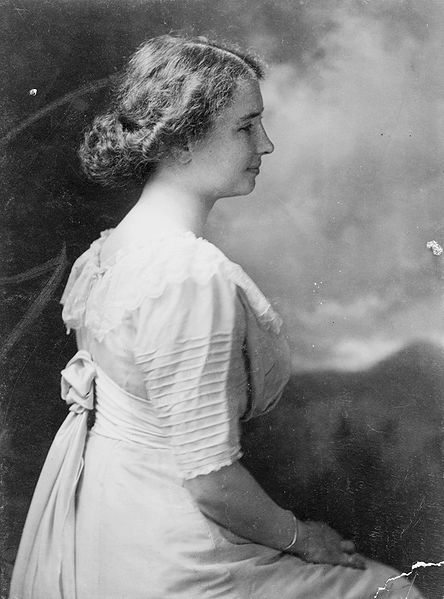Everybody has their own inspiring person. For me Helen Keller is my inspiring person. I knew about her because when i was at 3 grade of elementary school my teacher told the students to buy books. My friend bought a comic titled "Helen Keller". I didn't know the story tells about, and then i borrowed it and read it. I was so amazed by it. And i asked my mother to bought it, and i bought it. But now, the comic lost.
By the way, why do i choose Helen Keller? Because she is a great, cool, and smart women. With all her perfect imperfection. All her flaws make her so flawless. So here's a story of her life.
Helen Keller (1880-1968) was an American author, political activist and campaigner for deaf and blind charities. Helen because deaf and blind as a young child and had to struggle to overcome her dual disability. However, she became the first deaf-blind person to attain a bachelors degree and became an influential campaigner for social, political and disability issues. Her public profile helped destigmatise blindness and deafness, and she was seen as a powerful example of someone overcoming difficult circumstances.
Helen Keller was born 27 June 1880 in Tusculum, Alabama. When she was only 19 months old, she experienced a severe childhood illness, which left her deaf and blind (only a very partial sight). For the first few years of her life, she was only able to communicate with her family through a rudimentary number of signs; she had a little more success communicating with the six year old daughter of the family cook. However, unable to communicate properly, she was considered to be badly behaved, for example, eating from the plates of anyone on the table with her fingers.
In 1886, Helen was sent to see an eye, ear and nose specialist in Baltimore. He put them in touch with
Alexander Graham Bell, who was currently investigate issues of deafness and sound (he would also develop the first telephone) Bell, helped Keller to visit the Perkins Institute for the Blind, and this led to a long relationship with Anne Sullivan - who was a former student herself. Sullivan was visually impaired, but aged only 20 and with no prior experience, she set about teaching Helen how to communicate. The two maintained a long relationship of 49 years.
Learning to Communicate
In the beginning, Keller was frustrated by her inability to pick up the hand signals that Sullivan were giving. However, after a frustrating month, Keller picked up on Sullivan's system of hand signals through understanding the word water. Sullivan poured water over Keller's left hand and wrote out on her right hand the word 'water'. This helped Helen to fully understand the system, and she was soon able to identify a variety of household objects.
"The most important day I remember in all my life is the one on which my teacher, Anne Mansfield Sullivan, came to me. I am filled with wonder when I consider the immeasurable contrasts between the two lives which it connects. It was the third of March, 1887, three months before I was seven years old."
- Helen Keller, The Story of My Life, 1903, Ch. 4

Keller made rapid progress and quickly overcame her bad habits. She became proficient in braille, and was able to begin a fruitful education, despite her disability. Keller made more progress than anyone expected. She would later learn to write with a braille typewriter.
Keller came into contact with American author,
Mark Twain. Twain admired the perseverance of Keller and helped persuade Henry Rogers, an oil businessman to fund her education. With great difficulty, Keller was able to study at Radcliffe College, where in 1904, she was able to graduate with a Bachelor of Arts degree. During her education, she also learned to speak and practise lip-reading. Her sense of touch became extremely subtle.
Keller became a proficient writer and speaker. In 1903, she published an autobiography 'The Story of My Life' It recounted her struggles to overcome her disabilities.
Political Views
Keller also wrote on political issues, Keller was a strong supporter of the American Socialist party and joined the party in 1909. She wished to see a fairer distribution of income, and an end to the inequality of Capitalist society. She said she became a more convinced socialist after the 1912 miners strike. Her book 'Out of the Dark' (1913) includes several essays on socialism. She supported Eugene V Debs, in each of the Presidential election he stood for. In 1912, she joined the Industrial Workers of the World (IWW); as well as advocating socialism, Keller was a pacifist and opposed the American involvement in World War One.
Religious Views
In religious matters, she advocated the teachings of Emanuel Swedenborg, a Christian theologian who advocated a particular spiritual interpretation of the Bible. She published 'My Religion' in 1927.
Charity Work
From 1918, she devoted much of her time to raise funds and awareness for blind charities. She sought to raise money and also improve the living conditions of the blind, who at the time were often badly educated and living in asylums. Her public profile helped to destigmatise blindness and deafness.
Towards the end of her life, she suffered a stroke and she died in her sleep on June 1, 1968. She was given numerous awards during her life, including the Presidential medal of Freedom in 1964, by Lyndon B. Johnson.


 Keller made rapid progress and quickly overcame her bad habits. She became proficient in braille, and was able to begin a fruitful education, despite her disability. Keller made more progress than anyone expected. She would later learn to write with a braille typewriter.
Keller made rapid progress and quickly overcame her bad habits. She became proficient in braille, and was able to begin a fruitful education, despite her disability. Keller made more progress than anyone expected. She would later learn to write with a braille typewriter.